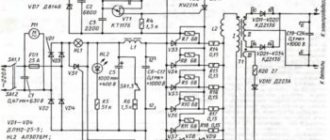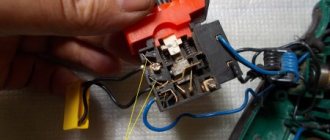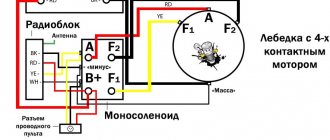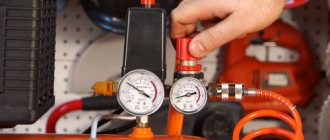Why are batteries connected?
Some self-powered devices require current and voltage values that are difficult to provide with existing standard galvanic power supplies.
As a rule, this is the need for more powerful current output, increased voltage or capacitance. To solve these problems, it is necessary to create various configurations of current source connections, each of which has its own characteristics.
Battery connection options
There are three diagrams for connecting batteries into assemblies with the required parameters:
- Sequential - the voltage of all batteries is added up;
- Parallel - the container is folded;
- Combined series-parallel - to increase capacity and voltage.
They all have certain features that you need to know to ensure the safety and long-term operation of batteries and the devices they power.
The main requirement for all switching methods is to exclude the use of batteries made using different technologies in the assembly (for example, you cannot connect Li-ion and Ni-Mh at the same time).
Series connection of batteries
To ensure sufficient voltage and acceptable operating time for electrical appliances, rechargeable batteries are often used, in which the anodes and cathodes of individual elements (sections) are connected in series with each other by conductors.
The anode and cathode of the extreme power sources of the resulting prefabricated battery are its common plus and minus. For a battery consisting of series-connected elements, the resulting voltage is equal to the sum of the voltages of the current sources used. The resulting capacity of the resulting battery is equal to that of the weakest of the connected batteries. When operating such an assembly, the same current flows through each element (both during charging and during discharge).
When six batteries are connected in series, each of which has a voltage of 1.2 volts and a capacity of 1200 mAh, an assembly of 6x1.2 = 7.2 v with a capacity of 1200 mAh will be obtained.
If elements with different capacitances are used in an assembly, then those with lower capacitance will have higher internal resistance compared to others. The voltage drop across them will be greater, which will lead to a rapid discharge of the weakest element during operation.
The more powerful batteries of the assembly will still be operational and the assembly will continue to be used. This will lead to a strong discharge of the weakest battery, which will reduce its resource and capacity.
When charging such an assembly, the weakest battery will charge before other elements, but due to the fact that the others have not yet charged, charging current will continue to flow through it, which will lead to overcharging and overheating. This is especially dangerous for batteries that contain lithium compounds due to their increased sensitivity to overcharging and severe discharge.
Important! Ultimately, the constantly repeated increased discharge and recharge of a weak assembly element will quickly lead to its failure. Therefore, when connecting in series, elements of equal capacity must be used. This can only be achieved by using power supplies from the same manufacturer, preferably from the same batch.
It is better to charge each power source of the prefabricated battery separately, or use an equalizing charge with voltage control (current regulation) on each element.
Parallel connection of batteries
In this case, one common conductor connects all the anodes, and the other connects all the cathodes of the connected batteries. This circuit is used when increased current strength of the collection battery is required.
The total capacitance (current delivered) of the resulting assembly is equal to the sum of the capacitances (current passed) of the connected power supplies. Its voltage will be equal to the voltage of the element with the largest electromotive force, and it will be the same at all sources of the resulting battery.
By connecting six batteries in parallel, each of which has a voltage of 1.2 volts and a capacity of 1200 mAh, you will get a 1.2v assembly with a capacity of 6*1200=7200 mAh.
Attention! When several identical sources with different voltages are connected in parallel, current flows from the source with a higher voltage to an element with a lower voltage.
This has a devastating effect on those that have less capacity. Due to the flow of currents, it is prohibited to connect disposable batteries in parallel, in which it leads to charging elements with a lower voltage, their overheating, leakage of electrolyte, or even an explosion.
In the case of a parallel connection of a source with a high voltage of small capacity to an element of a larger capacity, but with a lower voltage, an electrical short circuit of the weak battery occurs through the lower internal resistance of the strong one. Because of this, a strong current flows in a weak source, which leads to its gradual destruction.
In the case of high voltage on a battery with a larger capacity, a forced charge of the weak element occurs, which also has a detrimental effect on it. Based on this, before assembling the battery, it is recommended to equalize the voltage of each element to the same value.
Important! To avoid the destructive effects of current flow when connecting batteries in parallel, batteries of the same voltage should be used.
Series-parallel connection of batteries
If you take into account the rules for connecting batteries in series and parallel assemblies, you can create complex combined options using both methods simultaneously. This allows you to increase the resulting capacity and voltage, which is especially necessary in autonomous power supply systems, electric vehicles and other devices with high electrical current consumption.
The combination battery can be assembled in two ways:
- The required number of series-connected assemblies with the required voltage are compiled, and then they are combined into a single battery using parallel switching.
- Batteries are created with parallel-connected batteries of the required capacity, which are then switched in series until the required voltage is reached.
Important! It is necessary to understand that even if all connection rules are followed, it is impossible to select batteries with absolutely identical characteristics. This will inevitably lead to an imbalance of capacitance and voltage values, which over time will lead to increased wear of weaker batteries.
Battery connection diagrams for power supply
Rechargeable batteries (AB), depending on their purpose, are assembled from a certain number of energy-storing elements. Connection diagram
batteries depends on what purpose is being pursued. This could be an increase in battery capacity, an increase in voltage, or a combination of both of these parametric characteristics of the device.
Basically, batteries are assembled in series-parallel, and the assemblies themselves are used for intermediate or backup storage of electricity
There are 3 known and widely used options for connecting individual batteries into a battery: serial, parallel and mixed or combined.
Connection Precautions
With all methods of connecting batteries, a number of precautions must be observed:
- observe safety precautions for the operation of electrical installations to prevent electric shock (the main thing is not to create a circuit for the passage of current through the human body):
- observe the polarity of the connection;
- do not create short circuits;
- when assembling batteries, disconnect the load from them;
- connect the charger to the battery when it is disconnected from the network;
- carry out work in appropriate insulating clothing and shoes, without metal objects that could fall and short circuit the contacts;
- do not touch the battery terminals with your hands, especially with both hands on different poles (this is very dangerous on powerful high-voltage batteries);
- use a special tool with insulated parts;
- do not carry out work if you are in poor health;
- take into account the currents passing through the combined battery and the load and use conductors of suitable cross-section;
- when connecting elements into one battery, ensure reliable contact isolated from external influences;
- provide reliable protection of prefabricated batteries from short circuits and moisture;
- use batteries with the same characteristics and degree of wear;
- Carefully check the assembled battery for switching errors.
Increasing power supply capacity
There are often technical conditions when increased capacity is required from the power source while maintaining the operating voltage. In such cases, a parallel connection of batteries is used to complete the battery. This method of switching allows you to increase the total capacity of the power supply device several times, and in especially critical cases, tens of times.
Parallel connection of batteries with formulas
Parallel connection is carried out by switching single-pole terminals of current sources: the positive and negative terminals of the previous battery are connected to the same terminals of the next one. The total electrical capacitance of a battery switched in this way will be equal to the sum of the electrical capacitances of the individual sources included in the circuit. This means that when three batteries with a nominal capacity of 60 A*h are connected, the result is a device with an electrical capacity of 180 A*h.
As an example of connecting batteries using parallel switching, we can cite sources of uninterruptible or emergency power supply for devices and equipment. The batteries of heavy-duty vehicles and heavy special equipment with a large engine capacity are connected in parallel. Parallel switching has become widespread in the navy: here parallel-connected power devices are used to start auxiliary diesel engines, operate lighting, communication systems and life support in emergency situations.
What can lead to errors when connecting the battery?
To eliminate errors when connecting batteries, it is advisable to use special connectors that eliminate switching errors, for example, T-Plug adapters. If the batteries are connected incorrectly in one assembly, errors can be made that can lead to very serious consequences:
- when connected in parallel, a short-circuited circuit is formed, as a result of which a violent chemical reaction will occur in the batteries, which will very quickly lead to leakage of electrolyte, deformation of the case, fire or even explosion;
- when connected in series with incorrect polarity, the circuit is open, but when a load is connected, reverse current may appear through the incorrectly connected element, which will damage it;
- in the event of a prolonged short circuit of one or more batteries, the insulation will inevitably ignite, the conductors will melt, a violent reaction inside the battery, electrolyte leakage, case deformation, fire or explosion;
- in case of a short-term short circuit of the contacts, the battery will remain operational, but the condition of the electrodes inside the battery may deteriorate and the capacity may decrease;
- when using conductors that are not designed for operating currents, they will overheat, their insulation will melt, which can lead to a short circuit and the ensuing consequences.
Still have questions or have something to add? Then write to us about it in the comments, this will make the material more complete and accurate.
System health check
First of all, make sure that the batteries are intact, without cracks, without rust or traces of oxides. The wires at the terminals must be well secured. If everything looks fine, you can check the voltage and current.
- Checking the voltage drop when connecting a load. A load of a certain size is connected to the system and the voltage drop is measured with a multimeter or voltmeter. You can check several times, pausing between measurements to allow the charge to recover. The data obtained must be compared with the parameters of the type of battery used, taking into account the load size.
- Voltage measurement without load. Different types of batteries have their own open circuit voltage values. For example, for lead-acid it is 12.6 V.
- Using a load fork. If within 5-10 seconds the voltage increases slightly or is stable, then the system is working.
- Checking using special analyzers and testers. You can quickly measure voltage and determine capacitance using testers, for example, Coulomb, PITE, Fluke, Vencon.
- Full discharge/charge. This is perhaps the most reliable way. Using special devices (UKRZ), deep discharge is performed, and then full charging with continuous capacity monitoring. However, this method is very long, it can take from 15 hours to a day or more.
REFERENCE. If you are working with lead-acid batteries, pay attention to the electrolyte: its level should be several mm higher than the lead plates, and the density should be in the range of 1.23 - 1.31 g/cm3 (it can be measured with a hydrometer). A change in shade to brown may occur due to damage to the plates.
Finally, some tips on how to connect 18650 batteries:
- it is better to take batteries from Panasonic, LG, Samsung or Sanyo;
- Nickel strips are better than nickel plated metal strips;
- Under no circumstances should batteries be overheated, so use spot welding or quick soldering;
- before connecting, equalize the voltage on the batteries using a charger;
- place the BMS board on the assembly.
Source











